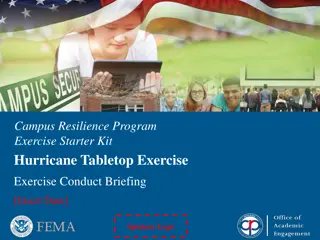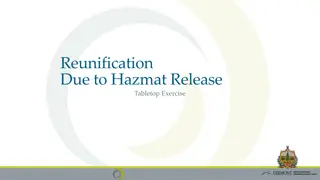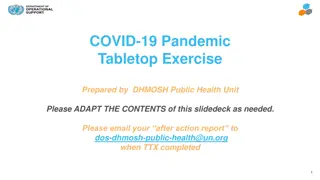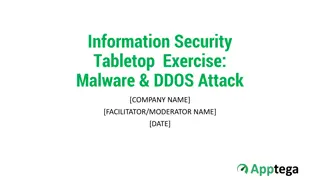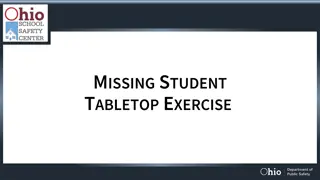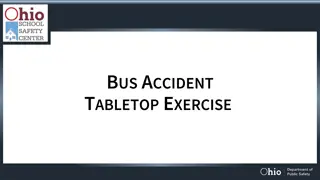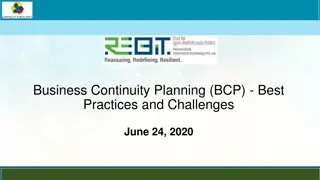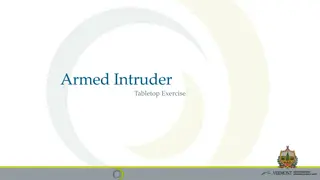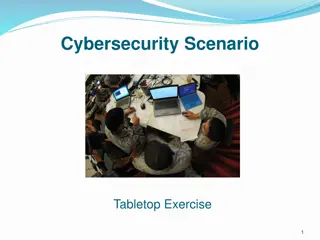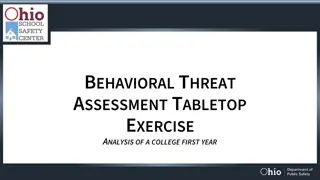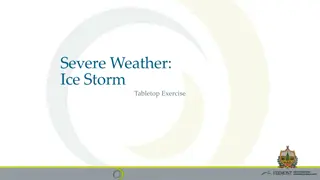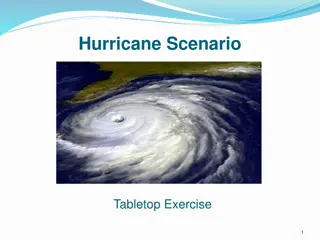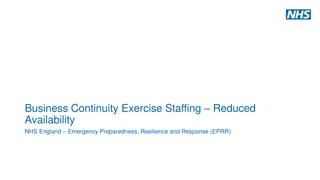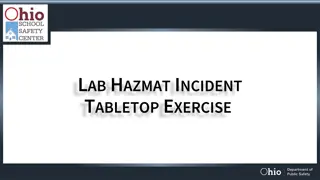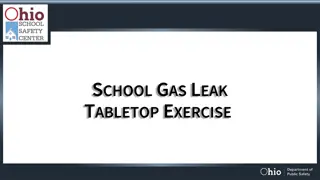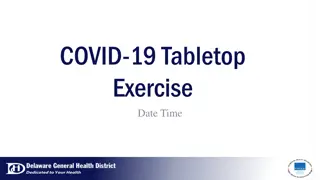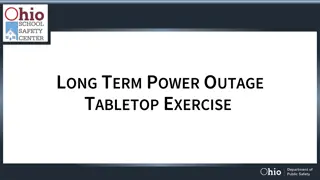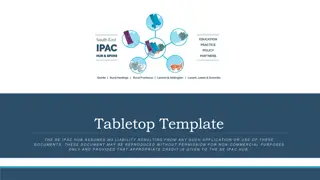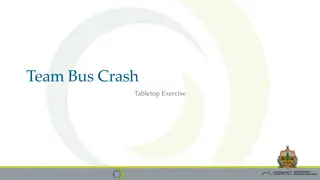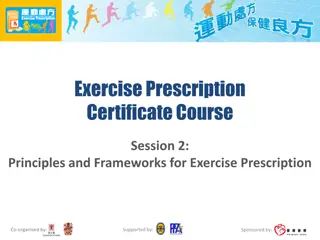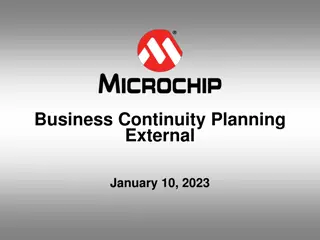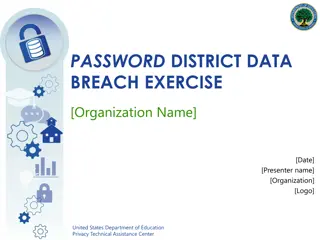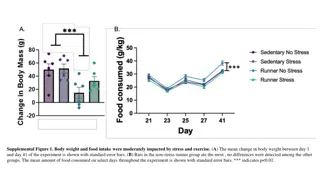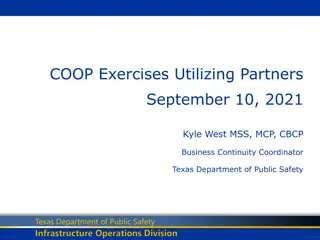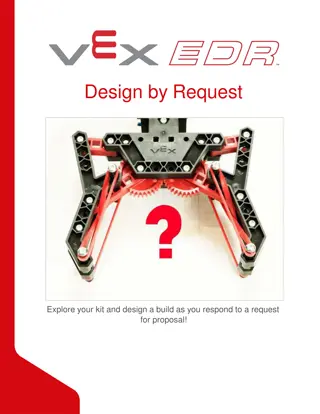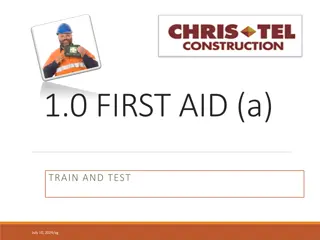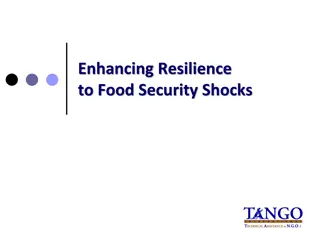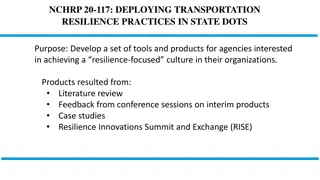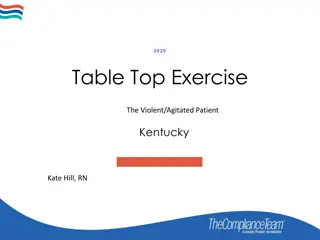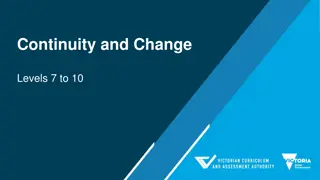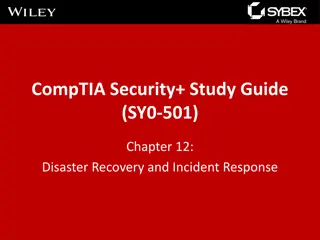Federal Mission Resilience and Continuity Tabletop Exercise Starter Kit
FEMA developed an Exercise Starter Kit for federal departments/agencies to conduct tabletop exercises on mission resilience and continuity. The kit includes sample slides, facilitator/evaluator guide, situation manual, and evaluation guides. Tailor the sample slide deck to your department/agency's needs, guided by discussions on continuity principles outlined in relevant directives. The exercise aims to assess current status, guide internal conversations, and develop an actionable roadmap for maintaining essential functions and services in response to various incidents.
Download Presentation

Please find below an Image/Link to download the presentation.
The content on the website is provided AS IS for your information and personal use only. It may not be sold, licensed, or shared on other websites without obtaining consent from the author. Download presentation by click this link. If you encounter any issues during the download, it is possible that the publisher has removed the file from their server.
E N D
Presentation Transcript
Federal Mission Resilience and Continuity Tabletop Exercise Starter Kit Sample Tabletop Slides | January 2021
INSTRUCTIONS READ FIRST FEMA developed this Exercise Starter Kit with sample conduct slides, a facilitator/evaluator guide, a situation manual and exercise evaluation guides (EEGs) that your federal department or agency (D/A) can use to conduct your own tabletop on federal mission resilience and continuity. Tailor this sample slide deck to meet the needs of your D/A. Use this document in tandem with the sample facilitator/evaluator guide and Situation Manual. Any changes made to this sample slide deck should be also be made to the sample facilitator/evaluator guide and Situation Manual. Slides with a blue background and note that says DELELE THIS SLIDE IN YOUR FINAL PRESENTATION are instructions and tips to help you design your tabletop for your own D/A. Delete all the slides with blue backgrounds and DELETE note in your final presentation. IMPORTANT: Update the slide numbers in the facilitator/evaluator guide to reflect the slide numbers in this sample slide deck after you finalize it. o Update content highlighted in red text based on individual deliveries of this tabletop.
BACKGROUND INFO (1 of 2) The suggested discussion questions build upon continuity principles and relevant guidance included in Presidential Policy Directive 40, Federal Continuity Directive 1 and Federal Continuity Directive 2. This tabletop is intended to be guided by a facilitator from your D/A. It is a framework to assess your current status and guide internal conversations and decisions around continuity. The results should allow you to develop an actionable roadmap tailored to your D/A s unique needs and missions. The exercise helps build the ability of D/As to continuously maintain capability and capacity to perform essential functions and services, whether in an everyday environment or while responding to all-hazards incidents, including natural hazards like hurricanes and earthquakes and manmade threats including cyberattacks.
BACKGROUND INFO (2 of 2) The suggested discussion questions focus on the three key elements of continuity: Continuity of Operations, Devolution and Reconstitution. The desired outcome is a better understanding of your D/A s ability to implement its operations, continuity of operations, devolution and reconstitution plans in response to a continuity incident; to identify gaps and issues; and recommend solutions and mitigation strategies. If you are conducting this tabletop remotely, address specific protocols (e.g., muting your microphones when not speaking, using a raise hand feature in the application) to provide an effective virtual meeting. If you are conducting this tabletop in person, address specific protocols for how you will recognize participants to speak (e.g., recognizing raised hands, proceeding in a certain order). Indicate time limits as necessary for timely, relevant and balanced discussion among all participants.
Welcome and Introductions [Name] [Title] [D/A] [Name] [Title] [D/A]
INSTRUCTIONS READ FIRST This tabletop is designed for both remote/virtual delivery and in-person delivery. Your D/A should determine the appropriate duration based on your own needs and delivery model. Multiple tabletop sessions may be needed to address the many potential planning considerations presented by this federal mission resilience and continuity exercise. Consider building a team with expertise across relevant disciplines (e.g., continuity, leadership, information technology, human capital, management and facilities) to help plan the tabletop sessions and participate in the discussions. Revise the Tabletop Schedule and Tabletop Overview slides as needed.
Tabletop Schedule Welcome and Introductions Tabletop Schedule Tabletop Overview Overview of the Scenario Facilitated Discussion Action Items and Takeaways Closing Remarks
Tabletop Overview Purpose: Purpose: Prepare [your D/A name] to review and assess your D/A s operations, continuity of operations, devolution and reconstitution plans; identify gaps and issues; and recommend solutions and mitigation strategies. Scope: Scope: This will be a [insert time] discussion-based tabletop. Following an overview of the scenario, participants will engage in a discussion based on the decisions and actions taken as the D/A considers continuity throughout the prevention, protection, response, recovery, and mitigation phases. The basis of discussion should be the D/A s existing operations, continuity of operations, devolution and reconstitution plans. Discussion questions are organized around the three key elements: Continuity of Operations, Devolution and Reconstitution.
Tabletop Objectives Identify how continuity planning is integrated throughout all existing plans, policies and procedures. Review existing general agency operations plans, policies and/or practices; discuss the decisions and actions to implement these plans, policies and practices; and identify gaps and challenges with their current structure and contents. Review existing continuity of operations plans, policies and practices; discuss the decisions and actions to implement these plans, policies and practices; and identify gaps and challenges with their current structure and contents. Review existing devolution plans, policies and/or practices; discuss the decisions and actions to implement these plans, policies and practices; and identify gaps and challenges with their current structure and contents. Review existing reconstitution plans, policies and/or practices; discuss the decisions and actions to implement these plans, policies and practices; and identify gaps and challenges with their current structure and contents. Identify potential solutions or mitigation strategies, both short- and long-term, for identified issues.
Tabletop Guidelines Our desired outcome from this tabletop is an actionable roadmap tailored to our D/A s unique needs and missions. [Insert additional D/A-specific outcome(s)]. This is an open, no-fault environment varying viewpoints, even disagreements, are expected. Base your responses on existing plans, policies, procedures, capabilities and resources. Consider different approaches and suggest improvements. There is no hidden agenda, nor are there any trick questions. [Insert additional guidelines as appropriate.]
INSTRUCTIONS READ FIRST On the following slide, provide an overview of the scenario. Explain that the State of the World is the fictitious scenario for the start of the exercise. Insert any D/A specific scene-setting information, including: Specific weather conditions may be added as an element of the scenario. If not, assume current weather conditions at time of conduct. o Specific impacts relevant to the D/A playing may be added as appropriate (e.g., impacts to area infrastructure). o
Scenario Overview: State of the World (1 of 2) [Specific weather conditions may be added as an element of the scenario. If not, assume current weather conditions at time of conduct.] [Specific impacts relevant to the D/A playing may be added as appropriate (e.g., impacts to area infrastructure).] According to media reports, multiple countries have been impacted by cyberattacks across multiple critical infrastructure sectors in the past two weeks. Internet service providers and telecommunications companies have reported significant connectivity and service degradation issues, escalating over the past week. Federal departments and agencies have reported the loss of personally identifiable information (PII) through an unknown compromise that has been uploaded to the dark web. Networks are degraded and experience connectivity issues with vendors, and users cannot access external websites.
Scenario Overview: State of the World (2 of 2) State agencies have abnormalities in their systems, to include slowdowns, traffic drop-offs and inoperability. State employee PII is found in open forums. Government sources report that analysis of the multiple reported incidents in the U.S. and overseas indicates a strong likelihood of recurring impacts within critical information and communication technology systems, as well as the potential for future physical effects on critical infrastructure. Localized blackouts have been reported within your headquarters area. Media reports that cyberattacks have impacted transportation operation centers resulting in significant degradation in traffic signal control, especially in urban areas. Numerous automotive collisions have been reported in the past four hours, and congestion is severe on all major highways. First responders are having trouble reaching crash victims in a timely manner.
INSTRUCTIONS READ FIRST Explain to participants that we are now engaging in the facilitated discussion portion of this tabletop. Start with a review of current operational status, followed by discussion questions organized around three key elements of continuity: Continuity of Operations o Devolution o Reconstitution o
Continuity of Operations Scenario Update (1 of 2) At 6 a.m., a significant power outage occurred that has impacted the entire region where your D/A HQ is located. Reports are coming in indicating that a significant portion of the region is without power. The cause of the outage has not been determined. Area utilities have not been able to provide an estimated time for power restoration. Area airports are reporting that they have lost primary power due to the power outage and are operating on backup power. Outbound flights are being canceled, and inbound flights are being diverted. Thousands of passengers are stranded at airports. [Washington Metro Transit Authority] is reporting that [Metro] is single tracking and operating on backup power. Significant delays exist and passengers are being encouraged to exit and use other means as soon as possible. [Virginia Railway Express and AMTRAK] report similar issues, and passengers are stranded across the region. [Adjust to reflect local transit as appropriate.]
Continuity of Operations Scenario Update (2 of 2) Area cell towers are still operational due to backup power, but significant increased volume in calls is taxing the system, and there are multiple reports of calls not going through. Social media traffic is significant. In addition to use by traditional media sources and government agencies, rumors and inaccurate information are being widely disseminated. [Insert specific weather conditions if this is an objective.] White House issues a continuity of government condition (COGCON) change to COGCON 1. D/As activate their continuity plans and begin continuity operations at alternate locations.
Discussion Questions: Continuity of Operations (1 of 3) 1. What plans and/or policies currently exist to guide your D/A s continuity of operations implementation? 2. What decisions are needed to implement your continuity plans without a COGCON 1 determination? 3. What actions, based on your continuity plan, would be taken at this point? 4. What logistics are needed to implement this plan?
Discussion Questions: Continuity of Operations (2 of 3) 5. Referencing your D/A s plan under the PACE (primary, alternate, contingency, emergency) model, what communication method is used? a. What is your primary method of communication? b. What is your alternate method of communication? c. What is your contingency communication method? d. What is your emergency communication method? 6. What is communicated to your workforce? By whom and how?
Discussion Questions: Continuity of Operations (3 of 3) 7. What gaps or challenges are you facing in moving to continuity of operations? 8. Is there any engagement with the devolution site or the Devolution Emergency Response Group?
Action Items and Takeaways For the continuity of operations discussion areas, identify: Major takeaways; o Actions needed; o Person or group responsible for those actions; o Timeline to reconvene or report back; and o Next steps. o
Devolution Scenario Update (1 of 2) 72 hours following the beginning of the continuity incident. Continuity operations continue at alternate sites. The Emergency Relocation Group team members who did not stay on-site at their D/A s alternate site report difficulties getting to the location for their shifts due to the ongoing area-wide blackout and the impact on local traffic signals and gas stations. Emergency Relocation Group team members report challenges with family preparedness matters, including family members wanting to evacuate to an area outside the impacted area, care for young children and pets and concerns about access to food and medications. Alternate sites are required to have the ability to operate for 30 days or until normal operations resume; some area sites are reporting challenges with supply delivery for generator fuel and other necessities. 21
Devolution Scenario Update (2 of 2) Area utilities report that a significant critical component in multiple transformers has become inoperable due to overheating. The damage is extensive and requires replacing major components or entire units. Limited replacement parts at the national level remove the possibility of short-term repairs. Utilities have estimated it will possibly be months before the system is fully operational. As the public becomes aware of the potential extended duration of the power outage, there are increased calls for assistance; reports of self-evacuation attempts to leave the area, which are hampered by a lack of powered fuel stations; and looting of grocery stores and other merchants. [Insert specific weather conditions if this is an objective]. D/A leadership directs implementation of the devolution plan to shift the mission to the devolution site outside the impacted area. 22
Discussion Questions: Devolution (1 of 2) 1. What plans and/or policies currently exist to guide your D/A s move to devolution? 2. What decisions are needed to implement your devolution plan? 3. What actions, based on your devolution plan, would be taken at this point? 4. What logistics are needed to implement this plan?
Discussion Questions: Devolution (2 of 2) 5. Referencing your D/A s plan under the PACE (primary, alternate, contingency, emergency) model, what communication method is used? a. What is your primary method of communication? b. What is your alternate method of communication? c. What is your contingency communication method? d. What is your emergency communication method? 6. What is communicated to your workforce? By whom and how? 7. What gaps or challenges are you facing in moving to devolution?
Action Items and Takeaways For the devolution discussion areas, identify: Major takeaways o Actions needed o Person or group responsible for those actions o Timeline to reconvene or report back o Next steps o
Reconstitution Scenario Update The Reconstitution Team stood up shortly after the decision to implement continuity operations. Planning for an eventual return to normal operations has continued throughout the event. Three months have passed since moving to alternate working conditions. Devolution locations have been performing essential functions, with varying levels of success depending on the robustness of the individual D/A s devolution capability. Reconstitution elements of the Devolution Team [were/were not] integrated into the efforts of the primary Reconstitution Team. [Insert specific weather conditions if this is an objective.] Area utilities have reported that repairs are close to completion and anticipate full power restoration within three days. D/A leadership directs implementation of reconstitution plans to begin to shift mission back to primary sites.
Discussion Questions: Reconstitution (1 of 3) 1. What plans and/or policies currently exist to guide your D/A s reconstitution? 2. Who is on your reconstitution team (e.g., management, human capital, facilities, records management, IT, security)? 3. What decisions are needed to implement your reconstitution plan? 4. Has your mission delivery degraded under current circumstances? 5. Are any functions not being performed or not being performed well? 27
Discussion Questions: Reconstitution (2 of 3) 6. How is the decision made as to whether to resume all functions when you return to normal operations? 7. What actions, based on your reconstitution plan, would be taken at this point? 8. What logistics are needed to implement this plan? 9. What other considerations may impact employees return to their primary work locations?
Discussion Questions: Reconstitution (3 of 3) 10. Referencing your D/A s plan under the PACE (primary, alternate, contingency, emergency) model, what communication method is used? a. What is your primary method of communication? b. What is your alternate method of communication? c. What is your contingency communication method? d. What is your emergency communication method? 11. What is communicated to your workforce? By whom and how? 12. What gaps or challenges are you facing in implementing reconstitution?
Action Items and Takeaways For the reconstitution discussion areas, identify: Major takeaways o Actions needed o Person or group responsible for those actions o Timeline to reconvene or report back o Next steps o
Break [Remove or adjust timing as needed] 31
INSTRUCTIONS READ FIRST The next section of the tabletop Action Items and Key Takeaways prompts participants to review the three key elements of continuity, Continuity of Operations, Devolution and Reconstitution, and identify next steps. Be sure to capture specifics! Identify any overarching themes or connections o Identify specific and actionable steps your D/A needs to take in each of the three elements of continuity. o Prompt the group to identify who is responsible (person or group) for taking each of those actions. o Agree on a timeline and a time to reconvene or report back. o
Summary of Action Items and Takeaways The discussions on each of the three key elements of continuity identified the following: Major takeaways; o Actions needed; o Person or group responsible for those actions; o Timeline to reconvene or report back; and o Next steps. o Review any major themes Identify any additional actions needed
Closing Remarks [Name] [Title] [D/A]


